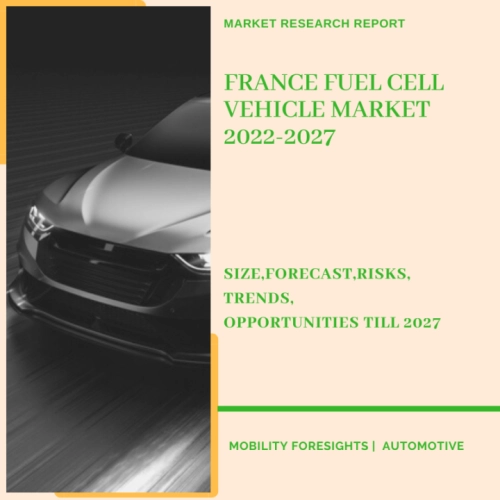
- Get in Touch with Us

Last Updated: Apr 25, 2025 | Study Period: 2022-2027
The parts of a fuel cell, which is actually a collection of cells, are quite similar to those of a battery. A fuel cell system features a matching pair of electrodes in each cell, similar to the latter. Both the cathode and the anode serve as sources of electrons, respectively.

To complete the system's chemistry, both electrodes must be submerged in and separated by an electrolyte, which can either be a liquid or a solid and must conduct ions between the electrodes in both cases.
The anode receives fuel, such as hydrogen, which is oxidised there to produce hydrogen ions and electrons. The cathode receives an oxidizer, like oxygen, and the hydrogen ions from the anode absorb electrons there.
The France Fuel cell vehicle market accounted for $XX Billion in 2021 and is anticipated to reach $XX Billion by 2026, registering a CAGR of XX% from 2022 to 2027.
The fuel cell manufacturing facility for Hyvia, a joint venture between Renault and Plug Power, has begun operations at the Renault Factory in Flins, France. At the new location, Hyvia intends to construct and test fuel cell modules based on Plug Power's technology.
The Renault Master H2-TECH panel van, platform chassis, and city bus will all be powered by the 30-kW fuel cell. The vehicles contain a 33 kWh battery in addition to the fuel cell and H2 tanks (which may hold between three and seven kg of hydrogen, depending on the model). Depending on the model, this should increase the 100 battery-electric miles to somewhere between 150 and 400 miles with hydrogen.
| Sl no | Topic |
| 1 | Market Segmentation |
| 2 | Scope of the report |
| 3 | Abbreviations |
| 4 | Research Methodology |
| 5 | Executive Summary |
| 6 | Introduction |
| 7 | Insights from Industry stakeholders |
| 8 | Cost breakdown of Product by sub-components and average profit margin |
| 9 | Disruptive innovation in the Industry |
| 10 | Technology trends in the Industry |
| 11 | Consumer trends in the industry |
| 12 | Recent Production Milestones |
| 13 | Component Manufacturing in US, EU and China |
| 14 | COVID-19 impact on overall market |
| 15 | COVID-19 impact on Production of components |
| 16 | COVID-19 impact on Point of sale |
| 17 | Market Segmentation, Dynamics and Forecast by Geography, 2022-2027 |
| 18 | Market Segmentation, Dynamics and Forecast by Product Type, 2022-2027 |
| 19 | Market Segmentation, Dynamics and Forecast by Application, 2022-2027 |
| 20 | Market Segmentation, Dynamics and Forecast by End use, 2022-2027 |
| 21 | Product installation rate by OEM, 2022 |
| 22 | Incline/Decline in Average B-2-B selling price in past 5 years |
| 23 | Competition from substitute products |
| 24 | Gross margin and average profitability of suppliers |
| 25 | New product development in past 12 months |
| 26 | M&A in past 12 months |
| 27 | Growth strategy of leading players |
| 28 | Market share of vendors, 2022 |
| 29 | Company Profiles |
| 30 | Unmet needs and opportunity for new suppliers |
| 31 | Conclusion |
| 32 | Appendix |